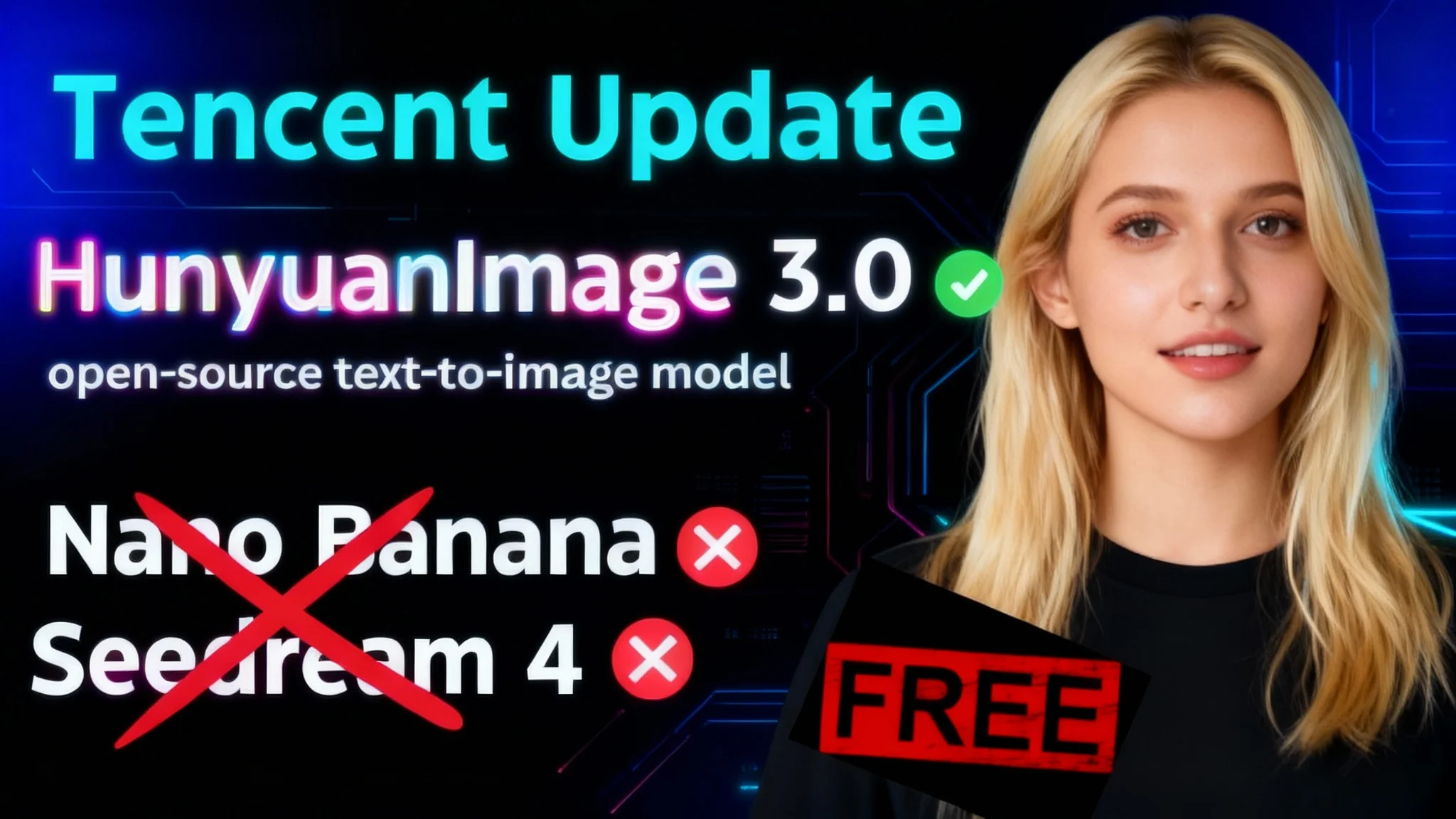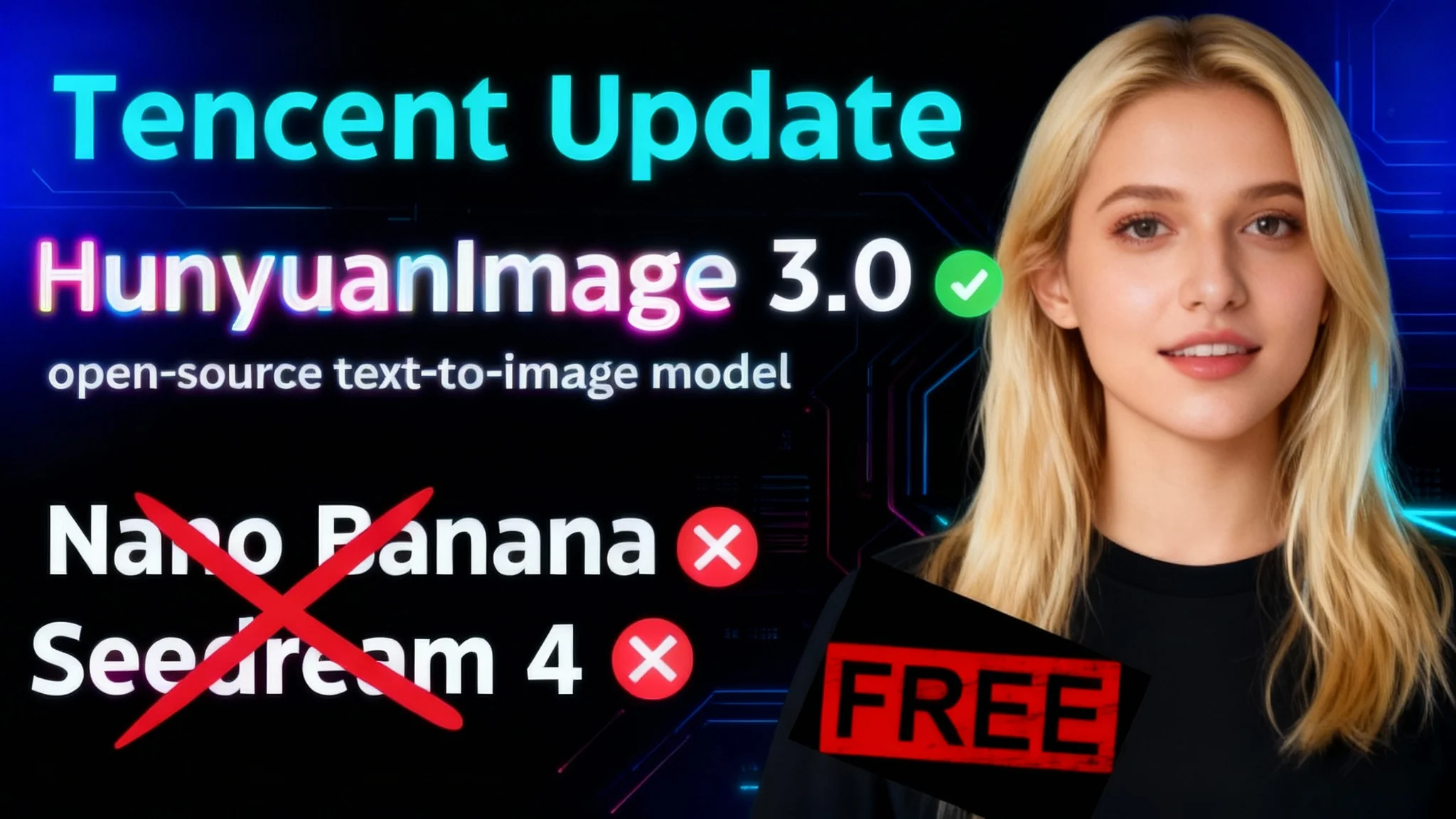HunyuanImage 3.0: Open-Source Text-to-Image by Tencent

Table Of Content
- What is HunyuanImage 3.0?
- HunyuanImage 3.0 at a Glance
- Early Results vs Popular Open Models
- Prompt Fidelity Test
- Multilingual Prompt Test
- How to Use the Free Web Demo
- Step-by-Step: Generate an Image Online
- Architecture and Training Highlights
- Unified Autoregressive Design
- Mixture-of-Experts Scale
- Training and Post-Training
- Capabilities: Reasoning and World Knowledge
- Running Locally: Requirements and Setup
- System Requirements (High-Level)
- Environment Setup (Typical Steps)
- Where to Access and Compare
- Key Features of HunyuanImage 3.0
- Practical Notes from Hands-On Use
- Recommendations for Testing
- Integrating HunyuanImage 3.0 into a Workflow
- Conclusion
Tencent has released HunyuanImage 3.0, a free and open-source text-to-image model. It is presented as the largest open model of its kind so far, with strong results across fidelity, detail, and prompt understanding.
I tested it head-to-head against two popular open models, Nano Banana and Seedream 4, using the same prompts. The difference in prompt accuracy and visual quality stood out, especially on prompts that demand precise spatial cues and multilingual input.
What is HunyuanImage 3.0?
HunyuanImage 3.0 is a native multimodal model for image generation. It follows a unified autoregressive design instead of the more common diffusion-only approach. The model is a mixture-of-experts (MoE) system with a total of 80 billion parameters, activating about 13 billion per token at inference.

The project is open source, with an accessible web demo and a repository that documents its architecture, training approach, and deployment paths.
HunyuanImage 3.0 at a Glance
| Attribute | Details |
|---|---|
| Model type | Open-source text-to-image, native multimodal |
| Architecture | Unified autoregressive framework (beyond standard diffusion-only setups) |
| Scale | Mixture-of-experts with 64 experts |
| Total parameters | ~80 billion |
| Active parameters at inference | ~13 billion per token |
| Availability | Free to test via web demo; repository available |
| Notable strengths | Prompt fidelity, multilingual prompts, visual detail, reasoning with world knowledge |
| Intended use | Image generation from text; research, development, and product integration |
Early Results vs Popular Open Models
I ran side-by-side comparisons with Nano Banana and Seedream 4 using identical prompts. The focus was on strict adherence to prompt details, particularly spatial relationships, and overall realism versus stylization.
Across these tests, HunyuanImage 3.0 consistently matched prompt constraints more closely. It also produced images with a more photographic finish when asked for realistic outputs. Seedream 4 held up on some constraints but tended toward a more painterly style. Nano Banana missed several fine-grained details and, in one case, failed on a non-English prompt.
Prompt Fidelity Test
One test used a prompt with a very specific spatial instruction. HunyuanImage 3.0 satisfied the constraint precisely. Seedream 4 also matched it, though with a different visual character. Nano Banana missed the key relationship required by the prompt.
This reflects a broader pattern: HunyuanImage 3.0 is strong at following exact wording and spatial cues in text. When the prompt calls out a small element in a precise location, it tends to get it right.
Multilingual Prompt Test
I also tested a non-English prompt copied verbatim from an image-generation site. HunyuanImage 3.0 generated a clean, realistic image from the non-English text. Seedream 4 returned an image, though with a more stylized look. Nano Banana returned an error on this input.
This suggests HunyuanImage 3.0 handles multilingual prompts well and maintains quality even when prompts are not in English.
How to Use the Free Web Demo
Tencent provides an online demo to try HunyuanImage 3.0 at no cost. The interface is straightforward: paste your prompt, select an aspect ratio, choose how many images to generate, and run.
The page may load in Chinese. A quick browser translation to English is enough to navigate. The demo produced consistent results in my tests, including with multilingual prompts.
Step-by-Step: Generate an Image Online
- Open the HunyuanImage 3.0 demo page.
- If the interface appears in Chinese, right-click in your browser and select “Translate to English.”
- Click “Try it now” to open the generator.
- Paste your prompt into the input field on the left.
- Set the aspect ratio and the number of images to generate.
- Click “Generate.” Wait for the results to render in the gallery.
Architecture and Training Highlights
The project’s repository outlines several design decisions that explain the model’s performance on precision prompts, multilingual inputs, and complex scene structure.
The core idea is to unify text and image modeling in a single autoregressive framework, paired with a large-scale mixture-of-experts setup. This gives the model capacity and flexibility across a wide range of prompts, from simple scenes to intricate compositions.
Unified Autoregressive Design
Instead of relying only on diffusion, HunyuanImage 3.0 uses a unified autoregressive approach to model both text and image modalities directly. This supports tighter coupling between prompt semantics and generated visuals, which helps with spatial accuracy and contextual consistency.
Mixture-of-Experts Scale
The model features 64 experts with a total of about 80 billion parameters. At inference, it activates roughly 13 billion parameters per token. This selective routing allows the model to bring significant capacity to bear where it’s most useful without running every parameter for every token.
Training and Post-Training
The team emphasizes careful data curation and reinforcement learning in post-training. The objective is to balance semantic accuracy (prompt adherence) with visual quality. This training pipeline appears to support both realism and faithful rendering of small, specified details.
Capabilities: Reasoning and World Knowledge
HunyuanImage 3.0 is designed to reason about entities, brands, and context described in the prompt. In practice, it recognizes well-known names and concepts and incorporates that background knowledge during generation.
It can also elaborate on sparse prompts with relevant details that fit the user’s intent, improving image completeness while staying aligned with the text. This is useful when the input prompt is short but implies additional context.
Running Locally: Requirements and Setup
You can run HunyuanImage 3.0 locally if you have the right hardware and software. The repository provides setup steps and environment guidance for Python and PyTorch.
Given the model’s scale and MoE routing, plan for a GPU with ample memory, a compatible OS, and a stable Python environment. The repository lists necessary versions and environment variables.
System Requirements (High-Level)
- Operating system: Linux or equivalent environments commonly used for ML workloads
- GPU: Recent-generation GPU(s) with sufficient VRAM
- CPU and RAM: Enough to support data loading and preprocessing
- Software: Python, PyTorch, CUDA stack compatible with your drivers
- Storage: Adequate disk space for model weights and caches
Environment Setup (Typical Steps)
- Install Python and create a clean virtual environment.
- Install PyTorch and CUDA versions compatible with your GPU drivers.
- Clone the repository and install dependencies from the provided requirements file.
- Download model weights as instructed in the repository.
- Run a quick inference test script to verify the environment.
Where to Access and Compare
You can try the official demo to gauge prompt handling, multilingual input, and overall quality. For broader comparisons, use a platform that hosts multiple open models side by side. Seedream 4 currently lists support for 2K image generation on some hubs, which makes for an informative comparison against HunyuanImage 3.0.
If you are evaluating models for integration, run the same prompts across all candidates, including both English and non-English inputs, and include tests with strict spatial or attribute constraints.
Key Features of HunyuanImage 3.0
-
Open-source access
- Public repository and free demo
- Suitable for research, development, and integration
-
Unified multimodal autoregressive architecture
- Joint modeling of text and image modalities
- Strong alignment between prompt semantics and visual output
-
Large-scale mixture-of-experts
- 64 experts, ~80B total parameters
- ~13B parameters activated per token during inference
-
Prompt fidelity and detail
- Consistent adherence to fine-grained, spatially specific instructions
- Balanced realism and clarity from curated training and RL post-training
-
Multilingual prompt handling
- Robust generation from prompts not written in English
- Stable outputs across languages that appear in common datasets
-
Reasoning with world knowledge
- Recognizes well-known entities and contexts
- Expands sparse prompts with fitting details while preserving intent
-
Flexible deployment
- Usable via web demo for quick tests
- Local setup supported for custom workflows
Practical Notes from Hands-On Use
- Prompt accuracy: In direct comparisons, HunyuanImage 3.0 outperformed Nano Banana on strict spatial instructions and matched or exceeded Seedream 4, depending on the case.
- Style and finish: HunyuanImage 3.0 produced more photographic results in tests that called for realism, while Seedream 4 leaned more painterly.
- Multilingual stability: HunyuanImage 3.0 handled non-English prompts cleanly. Nano Banana returned an error on one such input during testing; Seedream 4 produced an image.
Recommendations for Testing
- Use identical prompts across all models you want to assess.
- Include prompts with explicit spatial relationships, fine-grained attributes, and proper nouns.
- Add multilingual prompts to evaluate non-English handling.
- Compare both realism and stylization, based on your use case.
- Record failure modes (errors, missed constraints, artifacts) and measure consistency across runs.
Integrating HunyuanImage 3.0 into a Workflow
- Prototype with the demo to scope prompt patterns and desired styles.
- Move to local or hosted inference for controlled throughput and latency.
- Build prompt templates for repeatable output and better comparability across models.
- Track versioning of model weights and environment to ensure reproducibility.
Conclusion
HunyuanImage 3.0 brings a unified autoregressive approach and a large MoE design to open-source text-to-image generation. In testing, it produced accurate, detailed results, handled multilingual prompts well, and maintained strong adherence to specific instructions.
For teams exploring open models for production use or research, it is a compelling option to evaluate alongside existing favorites. With accessible tooling and documentation, it’s straightforward to try, compare, and integrate.
Related Posts

ChatGPT Atlas by OpenAI Enters the Browser Wars
Chrome dominates, Edge has Copilot, and Perplexity is building Comet—now OpenAI’s ChatGPT Atlas joins in. What this AI-first browser could mean for the web.

Beyond ChatGPT: DeepAgent, the AI Agent That Works While You Sleep
Discover DeepAgent, the autonomous AI that handles your job overnight. See why tech insiders say it’s beyond ChatGPT and Claude—and how it’s working today.

DeepSeek-OCR (VL2): How to Run Locally for Complex Documents
Discover DeepSeek-OCR (VL2), a vision-language OCR you can run locally for complex documents: layout, tables, charts, and visual Q&A. Learn setup steps and tips.
